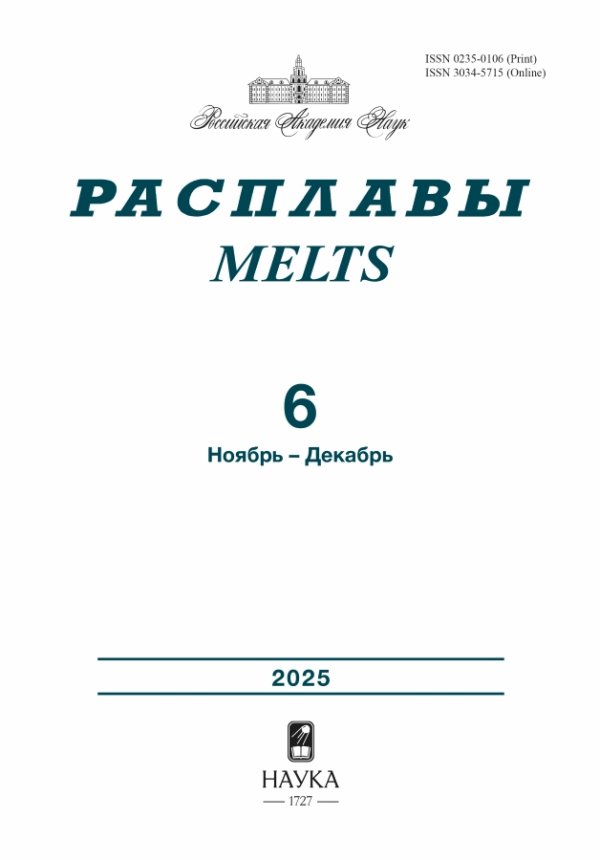Влияние оксида церия и основности шлаков на их вязкость и температуру начала кристаллизации
- Авторы: Уполовникова А.Г.1, Шартдинов Р.Р.1, Сметанников А.Н.1
-
Учреждения:
- Институт металлургии УрО РАН
- Выпуск: № 6 (2023)
- Страницы: 634-643
- Раздел: Статьи
- URL: https://journals.rcsi.science/0235-0106/article/view/162342
- DOI: https://doi.org/10.31857/S0235010623060105
- EDN: https://elibrary.ru/ZWFKDG
- ID: 162342
Цитировать
Полный текст
Аннотация
Исследование влияния содержания оксида церия и основности шлака на вязкость и температуру начала кристаллизации системы СаО–SiO2–Се2О3, содержащей 15% Al2O3 и 8% MgO, было выполнено с использованием симплекс-решетчатого метода планирования эксперимента, который позволяет получать математические модели, описывающие зависимость свойства от состава в виде непрерывной функции. Используя экспериментальные данные, построили математические модели, описывающие связь температуры заданной вязкости с составом оксидной системы. Затем совмещением полученных диаграмм состав–температура заданной вязкости на изотермический разрез диаграммы состав–вязкость получили совокупность изолиний вязкости. Обобщение результатов математического моделирования и графического отображения на изотермическом разрезе диаграммы состав-вязкость позволило получить новые данные о вязкости оксидной системы СаО–SiO2–Се2О3, содержащей 15% Al2O3 и 8% MgO, в интервале основности 2–5 и содержания 0–15% Се2О3. Экспериментальные данные показывают, что шлаки изучаемой оксидной системы, не содержащие оксид церия, характеризуются повышенной температурой начала кристаллизации и вязкостью в исследуемом диапазоне основности. Присутствие оксида церия в шлаках изучаемой оксидной системы обеспечивает в интервале температур 1500–1550ºС достаточно низкую вязкость и температуру начала кристаллизации. Увеличение содержания оксида церия в шлаках основностью 2–3 от 1 до 15% сопровождается снижением температуры начала кристаллизации от 1490 до 1410°С. Повышение основности до 5.0 приводит к повышению температуры начала кристаллизации до 1520°С. При температуре 1500°С вязкость шлаков основностью 2.0–3.0, содержащих 7–15% Ce2O3, изменяется в пределах 0.2–0.3 Па · с. Рост основности шлака до 3.0–5.0 при фиксированном содержании Ce2O3 на уровне 7–15% сопровождается увеличением вязкости шлаков до 1.0 Па · с и достигает 2.0 Па · с при снижении Ce2O3 до 1–6%. Увеличение температуры до 1550°C и фиксированной основности 3.0–5.0 сопровождается значительным снижением вязкости, которая не превышает 0.35 Па · с при содержании Ce2O3 1–15%.
Об авторах
А. Г. Уполовникова
Институт металлургии УрО РАН
Email: upol.ru@mail.ru
Россия, Екатеринбург
Р. Р. Шартдинов
Институт металлургии УрО РАН
Email: upol.ru@mail.ru
Россия, Екатеринбург
А. Н. Сметанников
Институт металлургии УрО РАН
Email: upol.ru@mail.ru
Россия, Екатеринбург
Список литературы
- Попель С.И. Теория металлургических процессов. М.: Металлургия. 1986.
- Соколов Г.А. Внепечное рафинирование стали. М.: Металлургия. 1977.
- Истомин С.А., Бахвалов С.Г., Денисов В.М., Пастухов Е.А., Овчинников Т.Ю. Вязкость и электропроводность расплавов систем CaO–B2O3 и ZnO–B2O3 // Расплавы. 1995. № 5. С. 36–43.
- Чумаков С.М., Ламухин А.М., Зинченко С.Д. Концепция производства низкосернистых сталей на ОАО “Северсталь” с учетом технологических аспектов // Тр. VI конгресса сталеплавильщиков. М.: АО “Черметинформация”. 2001. С. 63–66.
- Wu C., Cheng G., Long H. // High Temperature Materials and Processes. 2014. 33. № 1. P. 77– 84.https://doi.org/10.1515/htmp-2013-0025
- Zheng X., Liu Ch., Qi J., Sun J., Zhang X. // Journal of Sustainable Metallurgy. 2022. 8. P. 1104–1116. https://doi.org/10.1007/s40831-022-00544-6
- Zheng X., Liu Ch. // ISIJ International. 2022. 62. № 6. P. 1091–1098. https://doi.org/10.2355/ isijinternational.ISIJINT-2021-545
- Yang X., Long H., Cheng G., Wu C., Wu B. // Journal of rare earths. 2011. 29. № 11. P. 1079–1083. https://doi.org/10.1016/S1002-0721(10)60602-3
- Babenko A.A., Smirnov L.A., Upolovnikova A.G., Shartdinov R.R. Study of possibility of cerium reduction from slags of CaO–SiO2–Ce2O3–15%Al2O3–8%MgO system // IOP Conference Series: Materials Science and Engineering. “15th International Conference on Industrial Manufacturing and Metallurgy”. 2020. P. 012010.
- Wu Ch., Cheng G., Long H., Yang X.A // High Temp. Mater. Proc. 2013. 32. № 3. P. 207–214. https://doi.org/10.1515/htmp-2012-0119
- Уполовникова А.Г., Бабенко А.А., Смирнов Л.А., Михайлова Л.Ю. Прямое микролегирование стали церием под шлаками системы СaО–SiO2–Ce2O3–15%Al2O3–8%MgO дополнительными восстановителями // Известия ВУЗов. Черная металлургия. 2021. 64. № 8. С. 581– 587.
- Ким В.А., Акбердин А.А., Куликов И.С. Использование метода симплексных решеток для построения диаграмм типа состав-вязкость // Известия ВУЗов. Черная металлургия. 1980. № 9. С. 167.
- Ким В.А., Николай Э.И., Акбердин А.А., Куликов И.С. Планирование эксперимента при исследовании физико – химических свойств металлургических шлаков: Методическое пособие. Алма–Ата: Наука, 1989.
- Штенгельмейер С.В., Прусов В.А., Богечов В.А. Усовершенствование методики измерения вязкости вибрационным вискозиметром // Заводская лаборатория. 1985. № 9. С. 56–57.
- Истомин С.А., Хохряков А.А., Рябов В.В., Иванов А.В., Пайвин А.С. Влияние механо-активированных оксидов РЗЭ лантанидной группы на вязкость боратных расплавов // Расплавы. 2014. № 5. С. 69–77.
- Воскобойников В.Г. и др. Свойства доменных шлаков: справочник. М.: Металлургия, 1975.
- Бабенко А.А., Шартдинов Р.Р., Сметанников А.Н., Лобанов Д.А., Уполовникова А.Г. Построение диаграмм вязкости шлаков, содержащих оксиды хрома и бора, методом симплексных решеток // Металлы. 2023. № 3. С. 61–65.
Дополнительные файлы













